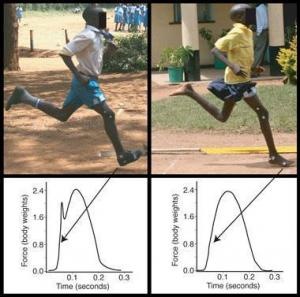光脚不怕穿鞋的
这是一句中国的俗语,今天的Nature上就有一篇文章“证实”了这一说法。
这篇文章的题目是 Foot strike patterns and collision forces in habitually barefoot versus shod runners Nature 463, 531-535 (28 January 2010),链接在这里。文章比较了光脚跑步和穿鞋跑步习惯上的区别,一般来说穿鞋的跑步者习惯用后脚掌着地,而光脚的喜欢用前脚掌着地(下左图)。对于冲击力来说,不同的脚掌着陆方式带来不同的响应(下右图)。看来对于保护关节来说,习惯光脚跑步还是很有帮助的。


文章英文摘要:
Humans have engaged in endurance running for millions of years1, but the modern running shoe was not invented until the 1970s. For most of human evolutionary history, runners were either barefoot or wore minimal footwear such as sandals or moccasins with smaller heels and little cushioning relative to modern running shoes. We wondered how runners coped with the impact caused by the foot colliding with the ground before the invention of the modern shoe. Here we show that habitually barefoot endurance runners often land on the fore-foot (fore-foot strike) before bringing down the heel, but they sometimes land with a flat foot (mid-foot strike) or, less often, on the heel (rear-foot strike). In contrast, habitually shod runners mostly rear-foot strike, facilitated by the elevated and cushioned heel of the modern running shoe. Kinematic and kinetic analyses show that even on hard surfaces, barefoot runners who fore-foot strike generate smaller collision forces than shod rear-foot strikers. This difference results primarily from a more plantarflexed foot at landing and more ankle compliance during impact, decreasing the effective mass of the body that collides with the ground. Fore-foot- and mid-foot-strike gaits were probably more common when humans ran barefoot or in minimal shoes, and may protect the feet and lower limbs from some of the impact-related injuries now experienced by a high percentage of runners.
相关的英文报道。
